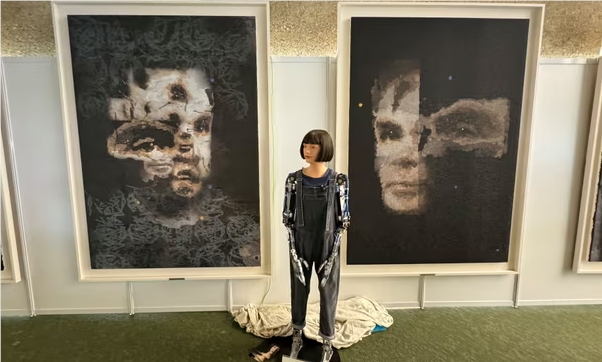A painting created by an artificial intelligence robot sold for $1.08 million at a Sotheby's auction in New York, setting a new record in the history of robot art auctions. The painting, titled "AI God. Portrait of Alan Turing," depicts the famous mathematician Alan Turing. The price far exceeded expectations and attracted widespread attention in the art and technology circles. The editor of Downcodes will take you to understand the story behind this painting and the new era of AI art it represents.
A painting created by a humanoid robot has sold for $1.08 million (approximately £566,000, AU$1,630,000) at an auction in New York, becoming the first robot painting to be sold at auction. Works of art. The painting, "AI God. Portrait of Alan Turing," which depicts the famous mathematician Alan Turing and stands 2.2 meters (7.5 feet) tall, exceeded the pre-auction price range of $120,000 to $180,000. .

Photo via Sotheby's/EPA
The auction was organized by the prestigious Sotheby's art institution. The auctioneer stated that the results of this auction are of great significance in the history of modern and contemporary art and reflect the growing intersection between artificial intelligence technology and the global art market. The robot that created this painting is called Ai-Da. It is the world's first hyper-realistic robot artist with the ability to make sounds. "The key value of my work is its ability to spark conversations about emerging technologies," Ai-Da said at the auction.
Ai-Da believes that Turing's portrait can provoke viewers to think about the mysteries brought about by artificial intelligence and computers, while also paying attention to the ethical and social impacts of these technological advancements. Turing, a mathematician and early computer scientist who made important contributions to breaking Nazi Germany's codes during World War II, expressed concerns about the use of artificial intelligence in the 1950s.
Ai-Da was developed by modern and contemporary art expert Aidan Meller, named after the world's first computer programmer, Ada Lovelace. Mailer leads Ai-Da's research and development team, working with artificial intelligence experts at the Universities of Oxford and Birmingham. Ai-Da generated ideas through conversations with studio members, and while discussing the theme “AI for Good,” she proposed creating a portrait of Turing. Ai-Da then made observations based on Turing's photos and created this painting.
Mailer said the painting's "soft tones and broken facial contours" seemed to hint at Turing's warnings about the challenges of managing artificial intelligence. He calls Ai-Da's work "ethereal and haunting," constantly questioning where artificial intelligence will take us and the challenges the world will face in the race to master its power.
This auction not only marks a milestone breakthrough in artificial intelligence art, but also triggers people's thinking and discussion on the future development direction of artificial intelligence. The successful auction of this painting heralds the huge potential of artificial intelligence in the field of art. It also brings new ethical and social challenges, which deserve our further attention and discussion.